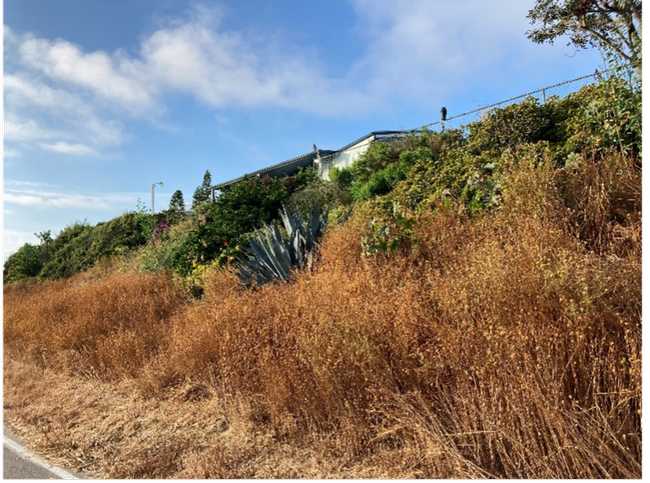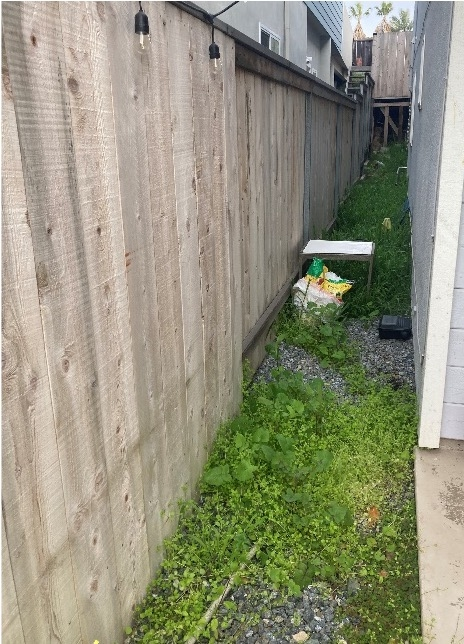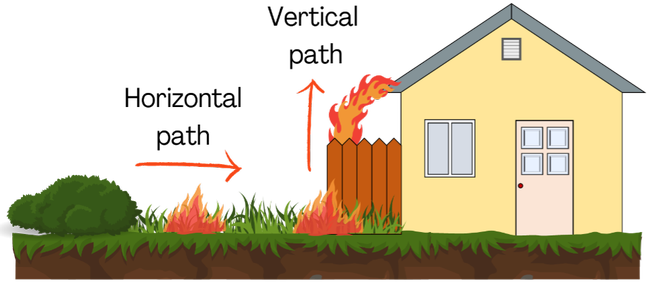How can weed control help with wildfire preparedness?

Given the large amount of rain in the winter of 2022-2023, you might have experienced a surge in annual grasses and fast-growing plants that cover most of the ground around your home and community. In my area, I observed invasive species like wild oats and mustard growing rapidly in the spring, then drying out as summer approached (Figure 1). Dry vegetation poses a major threat to our homes and communities, both in terms of ignition (possibility of starting a fire) and fire path (creating ways for a fire to spread).
Understand fire risks.
Fires require fuel to spread, and any combustible materials, including vegetation, wooden fences, or sheds can serve as fuel. Once ignited, these materials can create a direct fire path toward a residence. Fires also generate embers (small fuel brands transported by the fire plume or wind) that can ignite leaves or debris on roofs and gutters or penetrate directly into a building through vents. Embers can also accumulate near the house, especially within the first 5 feet. You can reduce your home's exposure to flames and embers by implementing defensible space and home hardening strategies. Creating a defensible space involves managing the landscape around buildings (such as houses, sheds, detached garages) to prevent fires from reaching them. Home hardening focuses on improving building components, such as vents, roofs, and gutters, that could reduce exposure to flame and ember ignition. Though it can seem overwhelming to figure out where to begin reducing your home's fire risk, in this article I will walk you through a few simple, cost-effective recommendations that have been shown to make a difference.

How do we build a fire in a firepit? We start by adding the smaller kindling, and then the larger pieces of wood. Why? Because twigs and small branches are easy to ignite, they burn quickly, and they can be used to ignite larger logs. Similarly, dry grasses and herbaceous plants are easier to ignite than other types of vegetation such as big shrubs or trees.
Weeds can be ignited directly by flames, or by embers and sparks landing nearby. A mower hitting a rock or sparks from a power tool can easily ignite dry grasses around your property. Using the firepit analogy, ground fuels such as weeds serve as kindling to spread the fire to larger fuels nearby such as fences, decks, and shrubs. Therefore, removing weeds from vulnerable locations, such as near fences (Figure 2), is a very effective way to prevent ignitions around homes and communities, and reduce potential fire paths. It's easier to remove weeds while they are still green. This reduces the risk of ignition caused by mowers and prevents invasive species from reaching maturity and producing viable seeds.
Weeds and fire paths
In addition to being easy to ignite, dry grass and herbaceous plants can also create fuel continuity. Fuel continuity, or fire path, refers to the way a fire could spread toward a building. There can be both horizontal and vertical paths (Figure 3). Weeds can provide horizontal continuity between shrubs or other combustible materials, increasing the intensity of a fire and bringing it closer to the house. Thus, it is important to create horizontal separations between groups of plants when maintaining vegetation. When burning grass ignites a fence, the fire “climbs up” from the ground, and if the fence is attached to the house, the fire can continue to climb. A fire can reach a building by using this vertical path, often called a “fuel ladder.” The risk of fire spreading to your house can be significantly reduced by removing these potential fire paths, starting with ground fuels like annual grass. However, other sources of ignition, such as embers, may create additional paths. It is therefore crucial to harden house components like vents (for example, by replacing their screens with a metal mesh of 1/8” or smaller) and keep your roof and gutters clean.
What can you do?
Maintaining the landscape and vegetation around your home and community is crucial to preventing losses during a wildfire. Prioritize your actions to reduce the risk of ignition and fire spread around your home starting from the building and working outwards. Below are some recommended actions for creating and maintaining a fire-resilient landscape:
- Remove annual weeds and litter from vulnerable locations such as fences, sheds, siding, and under decks.
- When mowing or removing grass, be careful of sparks from power tools or other machinery, especially near open areas. Make sure you have access to water in case of a fire emergency.
- Break horizontal and vertical fire paths by removing weeds and other vegetation that are easy to ignite (grass, dead twigs, and dry leaves).
- Prune lower branches of shrubs closer to the ground and clean their understory; trim lower limbs of trees that are close to other plants or buildings.
- Mulch can be effective for weed control, but it is also flammable. Do not place mulch in vulnerable locations within the first 5 feet around a structure.
- A fence creates a direct path for fires. If your fence is attached to your house, replace the last 5 feet with a noncombustible section or gate.
- Install metallic 1/8" mesh screens on vents to prevent ember entry.
- Regularly clean roofs and gutters, especially near roof intersections.
- Maintain your landscape throughout the year.
Preventing the ignition of your home during a wildfire is possible, but it requires a combination of home hardening and defensible space strategies. For more information related to wildfire preparedness, check the additional resources below:
- UC ANR Fire website: https://ucanr.edu/sites/fire/
- Reducing the vulnerability of buildings to wildfire: Vegetation and Landscaping Guidance: https://anrcatalog.ucanr.edu/Details.aspx?itemNo=8695#FullDescription
- Wildfire home retrofit guide: https://www.readyforwildfire.org/wp-content/uploads/Wildfire_Home_Retrfit_Guide-1.26.21.pdf
- Combustibility of landscaping mulches: https://naes.agnt.unr.edu/PMS/Pubs/1510_2011_95.pdf
- Landscaping and home hardening: https://defensiblespace.org/
Luca Carmignani is a UC Cooperative Extension Fire Advisor located at the UC South Coast Research & Extension Center in Irvine, CA.
Original source: UC IPM Home & Garden Pest Newsletter :: Summer 2023 issue
Editor - Associate Director for Urban & Community IPM/ Area Urban IPM Advisor
